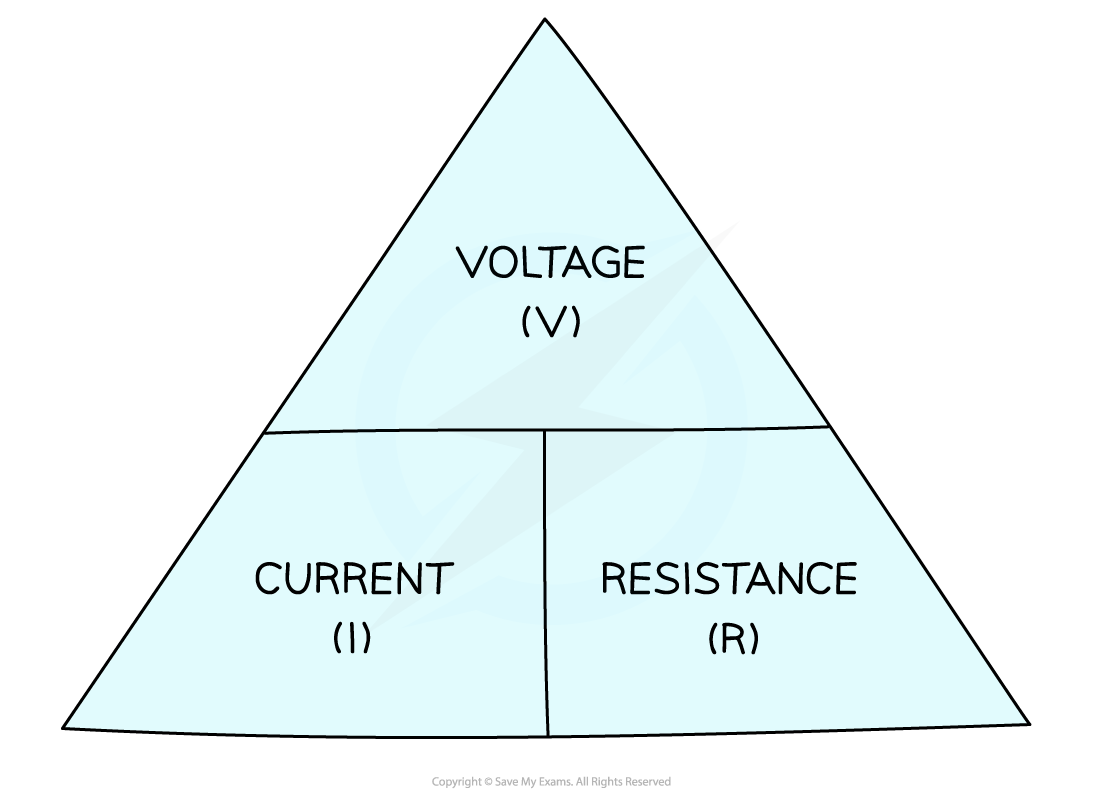Calculating Potential Difference, Current & Resistance (SQA National 5 Physics): Revision Note
Exam code: X857 75
Calculating potential difference, current & resistance
The current, resistance and potential difference of a component in a circuit can be calculated using the relationship:
Where:
= potential difference, measured in volts (V)
= current, measured in amperes or amps (A)
= resistance, measured in ohms (Ω)
This relationship is sometimes called Ohm's law, but only when the resistance of a component is constant
It can be rearranged with the help of the following relationship triangle:
Relationship triangle for voltage, current and resistance

Check out this revision note on motion relationships if you need a reminder on how to use relationship triangles
Worked Example
A 12 Ω resistor has a current of 0.3 A flowing through it.
Determine the potential difference across the resistor.
Answer:
Step 1: List the known quantities
Resistance,
Current,
Step 2: Write out the relationship between potential difference, current and resistance
Step 3: Substitute in the known values to calculate
Potential dividers
When two resistors are connected in series, the potential difference across the power source is shared between them
A potential divider is a circuit which splits potential difference from a power source, so only a fraction goes to a component (a voltmeter, in the diagram below)
Potential divider circuit diagram

A potential divider splits the potential difference of a power source between two components
The potential difference across each resistor depends upon its resistance:
The resistor with the largest resistance will have a greater potential difference than the other one
If the resistance of one of the resistors is increased, it will get a greater share of the potential difference, whilst the other resistor will get a smaller share
If one resistor is a variable resistor, the potential difference across the other resistor can be altered
This means the potential difference across any component in parallel with that resistor can also be altered
Resistors as potential dividers
When two resistors are connected in series, the voltage of the supply is split between the resistors
This potential difference splits in the same ratio as the resistance of the two resistors
The ratio of potential differences across each resistor can be found using the following equation:
Where:
is the potential difference across resistor 1 in volts, V
is the potential difference across resistor 2 in volts, V
is the resistance of resistor 1 in ohms, Ω
is the resistance of resistor 2 in ohms, Ω
For the two resistors connected in series:
the voltage
of the supply is equal to
the total resistance
is equal to
Therefore, the ratio can also be written as
Where:
is the potential difference of the supply in volts, V
Worked Example
The circuit is designed to light up a lamp when the input voltage exceeds a value.
When the lamp lights up, is 5.3 V.
Calculate the e.m.f. of the power source required to illuminate the lamp.

Answer:
Step 1: List the known quantities
Resistance of resistor 1,
= 12 kΩ = 12 000 Ω
Resistance of resistor 2,
= 20 kΩ = 20 000 Ω
Potential difference across resistor 2,
= 5.3 V
Step 2: Recall the equation for a potential divider
Step 3: Substitute the known quantities and determine the potential difference across resistor 1
Step 4: Determine the e.m.f. of the power source,
The e.m.f. of the power source when the lamp illuminates is 8.5 V to 2 significant figures
Examiner Tips and Tricks
When thinking about potential dividers, remember that the higher the resistance the more energy it will take to 'push the current through' and therefore the higher the potential difference.
This means that if a component (often shown as a voltmeter in questions) needs to be switched on by a change such as increased light or temperature, then the resistor it is in parallel with needs to become larger compared to the other resistor.

Unlock more, it's free!
Did this page help you?